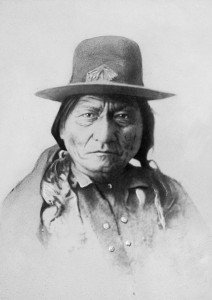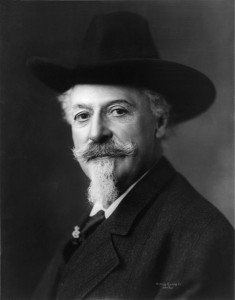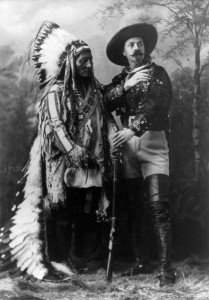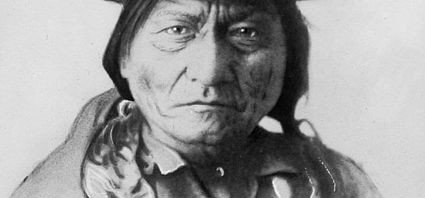The story about the great Lakota Sioux Chief Sitting Bull and William “Buffalo Bill” Cody were two life stories as dissimilar as can be imagined while at the same time had some interesting traits in common.
Thank you for reading this post, don't forget to subscribe!
There was probably no other Indian leader who resisted the United States takeover of Sioux native lands as much as Sitting Bull did. Sitting Bull was believed to have been born in 1831 near the Standing Rock Agency which was in the Dakota Territory. To be sure, Sitting was a warrior during his younger years. He was very involved in leading war parties during Red Cloud’s War which lasted from 1865 to 1868 and resulted in the abandonment of three army forts along the Bozeman Trail in Wyoming and Montana. Sitting Bull went on to become the central figure in the Sioux War of 1876 which resulted in the Battle of the Little Bighorn debacle. Following that battle, Sitting Bull along with a few hundred of his people fled to Canada in 1877. His stay in Canada was quite an ordeal for both he and his people. The winter weather was severe and food was in short supply. Finally, in July of 1881 Sitting Bull crossed back into the United States and surrendered himself to the army.
Shortly after the Sioux War of 1876-77, the Native Americans of the Montana and Wyoming area began returning to reservations. Some held out longer than others such as Crazy Horse, but in the end they all gave themselves up and were transported to various reservations. Steamboats were even used by the government to transport some of the Sioux. In fact, as a bit of irony, the steamboat Far West, which was used to transport many of the wounded soldiers from the Sioux battle of June 1876 back to Fort Abraham Lincoln, was also employed by the army to transport surrendering Sioux back downriver towards their reservations months later. This occurred all during the years of Sitting Bull’s self-imposed Canadian exile.

When Sitting Bull surrendered in 1881 he was moved down to the Standing Rock Agency which today is very near the North and South Dakota border. He and his people were kept separate from the others fearing that his presence night reignite trouble. At one point in 1881 Sitting Bull and his band were sent to Fort Randall in the southern part of the territory as prisoners of war but were moved back once again to the Standing Rock Agency in 1883. While Sitting Bull was totally aware that the struggle against the white man was over, he still resisted adopting a new way of life. In a way it was peaceful resistance. At the same time, the U.S. military was aware of Sitting Bull’s influence among his people.
What’s interesting to the historian of the Indian Wars and the old west in general is how Sitting Bull’s return happened about the same time that William Cody was organizing his Wild West. Cody was born in 1846 and went on to be a soldier, a buffalo hunter and finally one of the United States’ most successful show promoters. Buffalo Bill’s Wild West began in 1883 in North Platte Nebraska. This would have been the same year that Sitting Bull was relocated to the Standing Rock Agency.
Although Cody served as an army scout, he fully respected the rights of native Americans. Buffalo Bill was quite outspoken in his belief that the Indian troubles were a direct result of broken treaties on the part of the U.S. government. He went out of his way in calling the Native Americans our “former” foes who are now our friends. This was not necessarily an opinion held by many and it did set buffalo Bill apart from others. The former bison hunter also pressed for limits on hide hunting and the establishment of hunting seasons.
William Cody was known for his employment of Native Americans as part of his Wild West productions. In answer to criticism from some quarters, Cody simply pointed out that he was giving useful work to unemployed Indians. The one thing that could be said about the Wild West was that audiences were seeing the real thing. Native Americans performed as warriors attacking stagecoaches and wagon trains. They and their families were also encouraged to set up camps while traveling with the show similar to the camps they would have set up on their native land. Cody’s use of the native Americans as performers was one of the reasons for the Wild West’s enormous success.

In regards to Sitting Bull, Buffalo Bill Cody held no grudges. Sitting Bull was as entrenched in his beliefs as Cody was with his. Sitting Bull was asked by Buffalo Bill to join his show as a performer. Sitting Bull was given permission by the army to leave the reservation to join the Wild West. The great Sioux chief received about $50 a week for riding once around the arena, where he was a popular attraction. Not bad money at all in 1884. A story was started that Sitting Bull cursed his white audiences as he rode his horse in the arena but historians could find no proof that this really occurred. It was said that Sitting Bull did give out autographs for about one dollar each before and after performances. The Chief reportedly gave this money back to his people who were quite poor. Sitting Bull was also known to have given speeches promoting education for Native Americans and for all parties, Indian and white, to reconcile relations. Sitting Bull spent merely four months with Cody’s Wild West and afterward returned to the Standing Rock Agency. Sitting Bull was ultimately killed while being taken into custody in 1890 during what was called the Ghost Dance movement. The story of the Ghost Dance and Sitting Bull can be found on our link Ghost Dance..
Another related article that’s quite interesting is the story of Pawnee Bill and his Wild West show.
When you look at both Sitting Bull and Buffalo Bill Cody, it’s not too hard to see how both men came together in the Wild West shows. The early 1880’s were a time of transition for both. The Indian Wars were winding down, Sitting Bull was being held on the reservation and Buffalo Bill was preparing to showcase an entire era of American history to the world. If anything, Sitting Bull’s participation in Cody’s Wild West gave him a platform to press for aid for his people. Where at one time Sitting Bull was considered an enemy, he was now acting as a delegate for Native Americans everywhere. It’s also fitting that someone with the respect for Native American rights that Buffalo Bill Cody surely had, would also be in a position to help the Indian by offering a public platform for one of their most famous Chiefs.
(Photos are in public domain)

